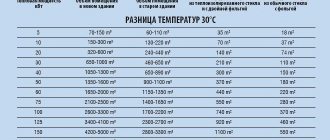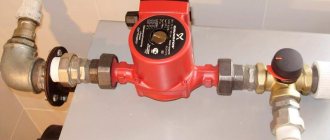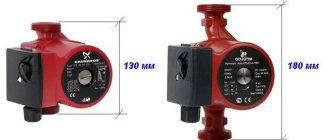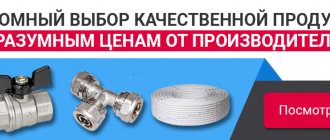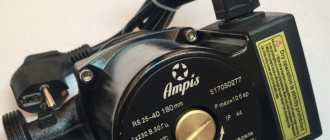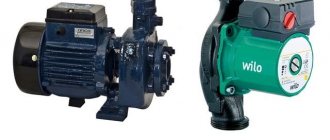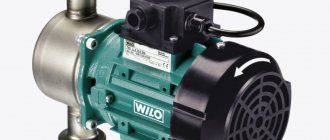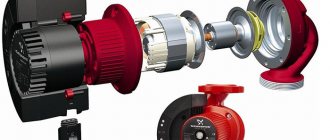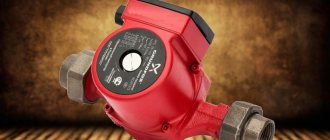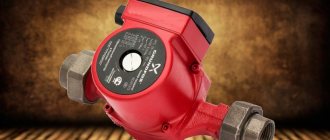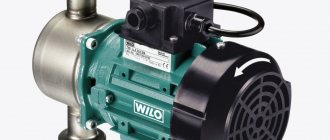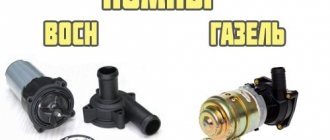Circulation pumps have long been used in organizing heating systems in homes. They are necessary to improve the temperature regime of the boiler, use complex heating circuits and make it possible to hide communications in the floor or walls. This equipment is now installed even in places where previously natural coolant circulation was quite sufficient.
Users have noticed that thanks to the pump, the heating system becomes more efficient and economical: the pipes are heated better and the load on the boiler is reduced. On the modern market you can find a wide variety of this type of equipment from different manufacturers. For example, you can purchase a Grundfos circulation pump that has good performance.
Who makes Grundfos pumps
Grundfos household circulation pumps are manufactured in the company's own factories, whose activities date back to 1945. The word Grundfos literally translates as “spring” was not chosen by chance. Grundfos produces pumping equipment for wells, heating systems, etc.
About 16 million units of equipment are produced annually, which corresponds to approximately 50% of all pumping equipment produced in the world. Grundfos models are used for private and industrial purposes, installed in mines and mines, and used for the extraction of mineral and thermal waters. Pumping equipment is operated in extremely unfavorable conditions.
One of the company's latest trends has been the widespread introduction of energy-saving technologies, which can significantly reduce energy consumption while maintaining the performance and reliability of equipment.
history of the company
The starting point for Grundfos should be considered 1945.
It was then that, on the initiative of the Danish engineer Paul Du Jensen, a small production was founded, which was called “Bjerringbro Pressestoberi og Maskinfabrik”. If you try to translate it, in Russian it will sound like the Bjerringbro injection molding and machining factory. During the first years of the company’s operation, the engineer devoted all his efforts to the creation and production of only one product - pumping equipment. Thanks to the high quality of the products, as well as a non-standard approach to solving most problems regarding design features and dimensions, it did not take the company very long for the manufactured units to become highly popular. As production capacity increased, more and more consumers chose products under this brand.
Until 1967, the company changed its name several times. And only this year the name Grundfos was assigned to it, by which today the manufacturer of high-quality pumps is recognized.
If we look at world statistics, then the share of pumping equipment manufactured under the Grundfos brand accounts for about 50% of global consumption. The reasons for this situation are not only related to high quality. This was also facilitated by the fact that the company today represents an international concern. In many countries there are plants, factories and small assembly shops created on the initiative of Grundfos management. They are also available in our country. Thus, in the Russian capital in 1992, a representative office of the company appeared , which later received the status of a subsidiary, the first decision of which was to launch a plant near the city of Istra.
Types of Grundfos water pumps
Grundfos heating circulation pumps are available in several basic modifications. Models can be divided into two groups:
- Circulation pump for hot water.
- Equipment designed to be connected to a heating system.
Some models are universal and can simultaneously connect to radiator heating systems, heated floors and hot water supply.
Installing a Grundfos circulation pump of the required modification will completely solve the issue of automation of the heating and hot water supply system.
The scope of application of Grundfos pumping equipment is not limited solely to domestic needs. The main directions are:
- Creation of a heating system for an apartment building.
- Installation for a private home, regardless of the type of water heating equipment and the type of fuel used.
- Installation in cooling and air conditioning systems.
- Connection to heated floors, radiators and heated towel rails.
- Industrial building.
Heating pumps Grundfos
For heating systems with forced circulation of coolant, the optimal choice is to install circulation equipment of one of the following modifications:
- Grundfos Alpha2 is one of the innovative models with a built-in electronic control unit. Circulation pumps for Grundfos heating and hot water supply Alpha2 have the following advantages: automatic adaptation to existing needs and system configuration, the ability to simultaneously connect to several water circuits. There is a built-in frequency converter. The daily electricity consumption of the Grundfos Alfa2 circulation pump, compared to models with a mechanical regulator, is reduced by 2-3 times. Capacity 3 m³/hour, water column head 6 m.
Alpha2 L - a distinctive feature of the model is the presence of a built-in frequency converter, a technology that uses the principle of permanent magnets. The Alpha2 L is controlled by pressing a single button. The pump control unit automatically selects the required mode, depending on the number of connected circuits. The design provides thermal protection. In the event of a power outage, the pressure relief valve is activated, preventing the coolant from boiling.
Alpha3 – pumps for water circulation in the heating system. They have a cast iron body. There are modifications intended for use in hot water supply. The housing of models for domestic hot water supply is made of stainless steel. The electronic control unit automatically adapts to the heating system. The Grundfos Alpha3 circulation pump design includes a function that prevents idling, a built-in air vent, and an indicator panel. The screen provides information about pressure and energy consumption. The model uses an innovative “summer mode” function. Automatic parameter adjustment reduces power consumption. Average consumption from 3 to 50 W.
Magna 1 – frequency controlled pump. An electronic control unit is installed. Magna 1 flanged pumps are suitable for domestic and industrial purposes. Nine fixed control modes are supported, and an automatic diagnostic system is present. Maximum pressure 16 bar. Dry running protection is provided. The pump is cooled by natural ventilation. The series also includes dual circulation pumps Grundfos Magna 1. Their use is convenient when connecting several circuits at the same time, or using one of the engines as a reserve. The motor protection module prevents rotor failure due to voltage surges. There is no need to install a stabilizer.
Grundfos Magna3 - the series includes both small circulation equipment and industrial pumping stations with a throughput of 70 m³/hour, a water column head of up to 18 m, and a maximum pressure of 16 bar. As in previous versions of pumping equipment, Grundfos Magna3 is distinguished by its silent operation mode, as well as the presence of energy-saving technology. The control unit has three built-in modes: AUTOADAPT, FLOWADAPT and FLOWLIMIT. Thanks to three built-in functions, the automatic operation of the pump analyzes the system and selects the most economical mode. When night falls, the pumping equipment switches to maximum economy mode. The kit includes protective heat-insulating casings. The type of regulation is selected by pressing a key. According to the type of installation, Magna3 is flanged pumps.
Grundfos UPS - three-speed circulation pumps with mechanical control. The optimal solution for a private house or cottage. The models have a simple design. The body is made of cast iron, bearings are made of stainless steel. Grundfos UPS are wet-rotor pumps with coolant fluid acting as a lubricant. The series also includes models with a bronze body, designed to meet the needs of domestic hot water supply. The pump operating mode is selected independently, depending on the parameters of the heating system.
How to choose a Grundfos circulation pump
I would like to note right away that it is quite difficult to independently make calculations and select a pump that is optimally suited to an individual heating system. Company consultants and special online calculators can help you make your choice. As practice shows, the decision to purchase the model you like is most influenced by:
- Technical characteristics of Grundfos circulation pumps - you should pay attention to power, throughput and type of design.
- It’s a good idea to make sure that you are purchasing an original device and not a fake.
- Design features.
- Cost and service life of the module.
Circulation pumps for Grundfos heating systems are offered in five basic versions. Selection of equipment requires the involvement of a specialist. Below are recommendations from professional installation teams and consultants.
How to distinguish a fake pump from an original Grundfos
How to calculate the required power of a Grundfos pump
Cost of Grundfos pumps
The average cost per unit of pumping equipment varies from 5 to 80 thousand rubles. The cost of the model is influenced by several factors:
- Technical characteristics of circulation pumps for heating of the Grundfos brand. Performance, the presence of a twin electric motor, and an automatic control unit - all this increases the cost of the model.
- Additional equipment. After connecting the pump, the heating system becomes volatile and stops working after a power outage. To eliminate this drawback, you will need to connect an uninterruptible power supply. Installation to heated floors is carried out using a special mixing unit.
The high cost is justified when you consider that maintenance of circulation pumps for Grundfos heating systems is not required. The models will work throughout their entire service life without any complaints and will help to significantly save on electricity.
Service life of Grundfos pumps
How to install a Grundfos pump correctly
Detailed recommendations for installation and installation are contained in the technical documentation included in the basic equipment package. But as practice shows, the instructions are often turned to in the very last place, when a breakdown has already occurred.
Things to remember when installing a circulation pump in a heating system:
- The pump is placed on the return line, usually immediately after the expansion tank.
- It is prohibited to start the electric motor until the heating system is filled with coolant.
- The correct installation position of the pump is vertical. Only in this position does the coolant completely lubricate all rubbing parts: bearings, rotor. When turned on with a dry rotor, the pump quickly fails. The service life is reduced if the internal volume of the housing is not completely filled with coolant, as happens with horizontal installation.
- Correct installation of the Grundfos circulation pump in the heating system takes into account the operating features. So, in case of frequent power outages, they are connected to a UPS and also installed in a bypass.
- The procedure for installing the pump is as follows: install the water circuit. Afterwards, using “Americans” (included in the kit) or couplings, the pump is connected. The heating system is filling up. Now you need to remove air from the pump. To do this, use a screwdriver to unscrew a special bolt on the top cover covering the engine.
- Selecting the operating mode - the pump works best at minimum speed. In quiet mode, bearings and other mechanisms that are subject to load during operation wear out less. But, as a rule, the minimum speed is not enough. The device has three stages of pump rotation speed. It is worth choosing the mode in which the heating system is evenly heated. Models with an electronic control unit independently select the required circulation speed.
Circulation pumps of the Grundfos brand are known all over the world - they are the most common heating equipment.
The Grundfos concern began its history in the 1950s in Denmark as a small company developing and producing components for heating and water supply in the private sector. Today there are 75 enterprises in 42 countries .
Operating modes
A modern recirculation pump for heating is a multifunctional device. Various samples of this equipment are capable of operating in the modes indicated in the passport, including “fixed speed”. All of them are equipped with a synchronous motor, the operation of which is controlled by a built-in processor. During operation of the unit, the control unit records the following main parameters:
- current strength;
- rotor speed;
- temperature in the working area and others.
Its presence allows you to adapt to a specific heating network with optimal energy consumption.
Types of devices for heating systems
Grundfos pumps designed to operate as circulation pumps are divided into two main groups , the difference of which lies in the operating conditions of the drive motor rotor.
If only the pump impeller comes into contact with the pumped liquid, then this design is called “dry rotor”.
If the transported liquid contains both the impeller and the motor rotor, it is a pump with wet rotor characteristics.
Both types of construction have their own characteristics and areas of application.
Dry
The dry rotor is good high efficiency and high power. Pumps of this type are also little sensitive to the quality of the coolant and can easily tolerate contamination from suspended matter and fine abrasives. Operates at temperatures significantly higher than the permissible operating values of glandless rotor pumps.
Photo 1. Disassembled Grundfos circulation pump for a heating system, equipped with a dry rotor.
The disadvantages are a shorter service life, comparatively high cost, slightly larger size, the need for regular maintenance (lubrication), and high noise. For this reason, models with a dry rotor are best installed in a separate room. But at the same time, they are able to “pump up” large cottages or even apartment buildings.
Wet
The wet rotor is more compact, almost silent, and extremely durable when installed correctly. Does not require maintenance during operation, but is less productive, with a relatively low efficiency - no more than 50%.
With overall low power consumption (on average 6–100 W depending on power, mode and load), this characteristic is not decisive.
This type of pumping equipment is extremely sensitive to the quality of the pumped liquid, since it is both a lubricant and antifreeze for the rotor. Therefore, such devices cannot operate at temperatures above 115 degrees and require the installation of a mesh dirt filter in front of the pump.
Photo 2. Grundfos compact circulation pump with a wet rotor, sensitive to the quality of the pumped liquid.
Wet-type devices are widely used in individual heating and water supply systems as additional circulation pumps for the make-up line.
Circulation pumps are installed in heating systems with forced or natural circulation. It is needed to increase heat transfer and to be able to regulate the temperature in the room. Installing a circulation pump is not the most difficult task; if you have a minimum of skills, you can do it yourself, with your own hands.
Step-by-step DIY installation instructions
In order for the unit to effectively perform its task, it should be installed on a horizontal plane. Equipment with a wet rotor is placed on the supply circuit, and equipment with a dry rotor is installed on the return circuit. The fact is that the “dry” version uses rubber or paronite gaskets, which deteriorate quite quickly when exposed to high temperatures.
It is advisable that a coarse filter be installed in front of the heating pump. It is necessary to protect equipment from small impurities entering it. This will extend the service life of the equipment.
It happens that electricity is cut off in the area where equipment is installed. In order for the pump to operate continuously, it is necessary to additionally install a bypass.
Some users cannot determine the correct direction of the pipes during installation. The manufacturer took this feature into account, so on the body of the pressure equipment you can see an arrow showing in which direction the rotor, and therefore the coolant, rotates.
As a rule, circulation equipment is sold without fasteners, so they will have to be purchased separately. When connecting the device to the network, professionals recommend using a separate cable coming from the distribution panel.
Main stages of work:
- All liquid is drained from the heating circuit. If it has been in use for a long time, high-quality washing is recommended.
- To connect equipment, bypass sections are cut in. A bypass is installed between the taps, which should complement the check valve or ball valve. This will protect the plastic liners during the welding process.
- The bypass pipeline is equipped with shut-off valves.
- A coarse filter is installed.
- A Mayevsky tap or automatic air valve is installed in the upper part of the bypass.
- The pump crashes. If the model is equipped with a “wet” rotor, then it should be placed horizontally.
- To connect to the network, it is better to use a separate grounded outlet.
- The pump is filled with coolant and its performance is checked.
At first glance, it seems that installation is not difficult. But this is only for experienced users. In practice, various problems may occur, so it is recommended that you carefully study the instructions supplied with the equipment. If experience is not enough, it is best to invite a specialist who will take into account all the requirements and configure the unit correctly. Read about long-burning wood-burning stoves on our website.
What is a circulation pump and why is it needed?
A circulation pump is a device that changes the speed of movement of a liquid medium without changing pressure. In heating systems it is installed for more efficient heating. In systems with forced circulation it is a mandatory element, in gravity systems it can be installed if it is necessary to increase the thermal power. Installing a circulation pump with several speeds makes it possible to change the amount of heat transferred depending on the outside temperature, thus maintaining a stable temperature in the room.
Cross-section of a circulation pump with a wet rotor
There are two types of such units - with a dry and wet rotor. Devices with a dry rotor have a high efficiency (about 80%), but are very noisy and require regular maintenance. Units with a wet rotor operate almost silently; with normal coolant quality, they can pump water without failure for more than 10 years. They have a lower efficiency (about 50%), but their characteristics are more than sufficient for heating any private home.
Harness
There are two types of heating systems - forced and natural circulation. Systems with forced circulation cannot work without a pump; systems with natural circulation work, but in this mode they have lower heat transfer. However, less heat is still much better than no heat at all, so in areas where electricity is often cut off, the system is designed as hydraulic (with natural circulation), and then a pump is installed into it. This gives high heating efficiency and reliability. It is clear that the installation of a circulation pump in these systems is different.
All heating systems with heated floors are forced - without a pump, the coolant will not pass through such large circuits
Forced circulation
Since a forced circulation heating system without a pump is inoperative, it is installed directly into the gap in the supply or return pipe (of your choice).
Most problems with the circulation pump arise due to the presence of mechanical impurities (sand, other abrasive particles) in the coolant. They can jam the impeller and stop the motor. Therefore, a mesh dirt filter must be placed in front of the unit.
Installing a circulation pump in a forced circulation system
It is also advisable to install ball valves on both sides. They will make it possible to replace or repair the device without draining the coolant from the system. Turn off the taps and remove the unit. Only that part of the water that was directly in this piece of the system is drained.
Natural circulation
The piping of the circulation pump in gravity systems has one significant difference - a bypass is required. This is a jumper that makes the system operational when the pump is not working. One ball shut-off valve is installed on the bypass, which is closed the entire time the pumping is running. In this mode, the system operates as forced.
Installation diagram of a circulation pump in a system with natural circulation
When the electricity goes out or the unit fails, the valve on the jumper is opened, the valve leading to the pump is closed, and the system operates as a gravity system.
Installation features
There is one important point, without which the installation of the circulation pump will require rework: it is necessary to rotate the rotor so that it is directed horizontally. The second point is the direction of flow. There is an arrow on the body indicating which direction the coolant should flow. This is how you turn the unit so that the direction of movement of the coolant is “in the direction of the arrow”.
The pump itself can be installed both horizontally and vertically, just when selecting a model, make sure that it can work in both positions. And one more thing: with a vertical arrangement, the power (pressure created) drops by about 30%. This must be taken into account when choosing a model.
Where to put
It is recommended to install a circulation pump after the boiler, before the first branch, but on the supply or return pipeline it doesn’t matter. Modern units are made from materials that can withstand temperatures up to 100-115°C. There are few heating systems that work with a hotter coolant, so considerations of a more “comfortable” temperature are untenable, but if you feel safer, put it in the return line.
Can be installed in the return or direct pipeline after/before the boiler up to the first branch
There is no difference in hydraulics - the boiler, and the rest of the system; it makes absolutely no difference whether there is a pump in the supply or return branch. What matters is the correct installation, in the sense of strapping, and the correct orientation of the rotor in space. Nothing else matters.
There is one important point regarding the installation location. If the heating system has two separate branches - on the right and left wings of the house or on the first and second floor - it makes sense to install a separate unit on each, and not one common one - directly after the boiler. Moreover, the same rule remains on these branches: immediately after the boiler, before the first branch in this heating circuit. This will make it possible to set the required thermal conditions in each part of the house independently of the other, and also in two-story houses to save on heating. How? Due to the fact that the second floor is usually much warmer than the first floor and much less heat is required there. If there are two pumps in the branch that goes up, the speed of movement of the coolant is set much lower, and this allows you to burn less fuel, without compromising the comfort of living.
